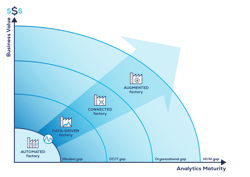As process manufacturers move along their digitalization journey, they begin taking steps to improve their level of digital maturity. Those in the beginning stage are just starting to automate the factory floor while others in later phases are applying advanced analytics to find hidden clues in their operational data. But once a company finishes the final phase of their current journey, where do they go next? And how do they get there?
The next wave of innovation, commonly known as Industry 5.0, is an extension of the current digital transformation. In short, companies during this leg of their journey will begin to pair human intelligence with their artificial counterparts. Operational experts who use advanced analytics also will find they already are on the path toward Industry 5.0. Here is why that will matter in the future.
A digitalization journey: The bedrock of Industry 5.0
Industry 5.0 is the ongoing digital transformation of traditional manufacturing and industrial practices. It represents a shift toward newer technologies, such as advanced analytics, the Industrial Internet of Things (IIoT), artificial intelligence (AI) and machine learning. While Industry 4.0 makes factories autonomous, Industry 5.0 puts human intelligence next to artificial intelligence to achieve levels of operational performance that neither could achieve on its own.
While the goals of Industry 4.0 are to enable autonomous decision-making processes, monitor assets and processes in real-time, and enable equally real-time connected value creation networks through early involvement of stakeholders, Industry 5.0 strives to provide companies with a way to improve communication and collaboration between humans and their automated counterparts. Like its predecessor, the extension of the Fourth Industrial Revolution also seeks to optimize manufacturing processes. But in this case, the skill and experience of an operational expert are necessary to make more accurate decisions.
For example, smart systems might suggest a course of action that they believe is in the best interest of production. Yet, these systems fail to consider outside influences on process behavior. An operational expert might need to take a process offline for maintenance or some other reason, which could change the suggested action from the smart systems. Thus, the operational expert’s reasoning skills are necessary to decide which action to take. They also can adjust smart systems to account for downtime, which gives them more accurate recommendations.
However, the result is not instantaneous. Integration between operational experts and their processes is part of the transformation. When companies first start their digital journey, they begin a series of phases for improvement. Reaching the next phase represents a growing digital and analytics maturity level.
Process manufacturing companies also follow a similar path.
- In an automated factory, sensors report information back to a historian, which collects and stores the data. During this phase, companies make small improvements in areas such as safety and production spills. To make further gains, companies must bridge a mindset gap that exists between the workforce and recent technology. Overcoming this divide often is a matter of change management.
- In the data-driven factory phase, companies begin using advanced analytics to find hidden clues in their operational data. Operational experts also close a communications gap between engineers and data scientists because these solutions allow for better collaboration among the teams.
- A connected factory has bridged the gap between information technology and operations technology. By comparing time-series data with details from third-party business systems and other sources, companies can democratize data for everyone in the organization. Previously, this contextual data often was trapped in silos as it was stored and managed in separate systems and by separate departments.
- An augmented factory is the most advanced level of Industry 4.0. Here, companies deploy machine learning techniques to optimize production and solve the most challenging process issues.
Closing the gap between human and artificial intelligence is required before going further on the journey. Creating a hybrid model that applies the precision of AI with the creativity and reasoning of people is the preferred approach. People must be able to work productively alongside and with their artificial counterparts. This, then, is Industry 5.0.
Placing process experts at the center
The purpose of advanced analytics software is to provide operational experts with information they need to run a process optimally. Traditionally, an analysis was not available directly to an engineer. Evaluating sensor-generated data required the help of a data scientist. This used to be stressful, as data scientists and operational experts often speak different languages.
When it comes to data-driven operational improvement, however, everyone can agree. Companies still use data scientists for the 2-3% most critical assets, but a modern advanced analytics solution empowers operational experts to analyze about 80% of the data themselves. For an even deeper analysis, data scientists can deploy algorithms inside the advanced analytics software.
By adding contextual data, operational experts get a more holistic view of process behavior. Contextual data includes maintenance records, laboratory quality readings, shift reports and weather logs. It allows operational experts to run a more precise and cleaner analysis.
Providing operational experts with direct access to key performance parameters and contextual insights puts them in the center position of control. Meanwhile, advanced analytics software puts the resources to improve process behavior, increase overall efficiency and make a variety of other improvements at their fingertips. They also can support in accelerating the company to achieve its sustainability goals.
The need for human intelligence
People are an afterthought during the early phases of a digital transformation, and some may feel as though automated systems will replace them outright. This will not occur. Although Industry 4.0 focuses on technology, AI was never meant to replace human intelligence. Instead, advanced technology provides operational experts with the information they need to make informed decisions about process behavior and its effect on production over time.
A fully augmented factory is the last phase of Industry 4.0, and the threshold to the next evolution. At this level, workers throughout the organization have embraced advanced analytics for evaluating manufacturing processes. Operational experts can begin to automate tasks as information becomes available. They also can apply AI and machine learning techniques. Adding these layers of technical maturity allows operational experts to decrease repetition, create anomaly detection models and get prescriptive recommendations to take corrective actions. They also can plan the optimal schedule for maintenance to prevent costly downtime. As they begin to manage by exception, they are laying the foundation for Industry 5.0.
Ready for the rest of the journey
Companies that have not started their digitalization journey need not feel overwhelmed. Everyone begins at the same phase. By the time a company begins analyzing operational data, it easily can segue to Industry 5.0. Operational experts developing a deeper analytics maturity level also gain valuable insights about the processes they manage. Advanced analytics solutions empower operational experts to solve most production challenges themselves while providing a more complete overview of production and data science integration.
With the insight necessary to make a host of improvements, operational experts using advanced analytics will be ready for the journey ahead.
Nick Van Damme is the director of products at TrendMiner, where he is responsible for translating the vision of TrendMiner into the product roadmap. Nick is passionate about using advanced analytics, big data and manufacturing intelligence to support digital transformations, Industry 4.0 and the Industrial Internet of Things.
Matt Saxton is the editor at TrendMiner. Matt worked for 20 years in the newspaper business as a news editor, city editor and managing editor before pursuing graduate work in data science and cybersecurity.
TrendMiner



